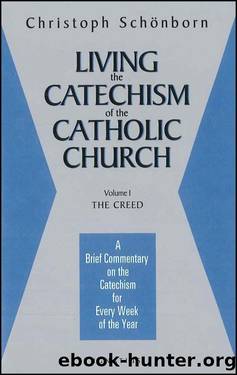Living the Catechism of The Catholic Church: 1 by Schoenborn Christoph Cardinal

Author:Schoenborn, Christoph Cardinal [Schoenborn, Christoph Cardinal]
Language: eng
Format: epub
Tags: Spiritual & Religion
ISBN: 9780898705607
Publisher: Ignatius Press
Published: 2011-01-11T16:00:00+00:00
26
The life of Jesus
During the course of the year, the Church celebrates the whole cycle of events in the life of Jesus, from his conception (March 25) through to his Ascension. These liturgical celebrations serve not only the purpose of commemoration. It is true that Jesus lived at a definite time, when Augustus was emperor of Rome. Jesus was crucified âunder Pontius Pilateâ. All these things belong to the past, and we can remind ourselves of them just as we can of other events from an earlier time.
Yet the situation is different regarding the life of Jesus. For we believe and profess that Jesus is âtrue God and true manâ. Everything that he did and suffered as a man, between his birth in Bethlehem and his Resurrection in Jerusalem, was unique: not a transient human life, but the once-only life on earth of the eternal Son of the Father. Jesusâ entire life is âdivine-humanâ.
The Catechism devotes a self-contained section to âthe mysteries of Christâs lifeâ (CCC 512-60). The word âmysteriesâ indicates that, âfrom the swaddling clothes of his birth to the vinegar of his Passion and the shroud of his Resurrection, everything in Jesusâ life was a sign of his mysteryâ (CCC 515).
To inquire into Christâs life through the methods of historical science is surely justifiable. It is helpful to be aware of the history of those times, the conditions of life in Galilee, the religious customs and beliefs of first-century Judaism. Archaeological research has brought pieces of evidence about Jesus more clearly to light. Biblical scholarship has contributed much to construction of a historical picture of Jesus and his environment that is as exact as possible.
Every pilgrim to the Holy Land knows how touching it is to see the land in which Jesus lived. Yet what also moves us is the mystery of him who lived here. And when we reflect, in Nazareth, on the Annunciation, or see, in Capernaum, the synagogue where Jesus spoke his words on the âbread of lifeâ, or are reminded, at Tabgha, of Jesusâ preaching from Peterâs boat, then all of this is present. Nothing is simply past. It lives, because he who lived it at that time has risen, and lives eternally, in all his humanness, both with the Father and for us. âHe remains ever âin the presence of God on our behalf (Heb 9:24), bringing before him all that he lived and suffered for usâ (CCC 519).
Saint Ignatius of Loyola, in his little book of Spiritual Exercises, recommends that, when we meditate on the life of Jesus, we should concretely imagine the relevant places and scenes and also try to enter into Jesusâ joy and sadness. This method is intended to have the effect that we not only regard Jesus as our model but seek to live together with him. For, as the Catechism says: âChrist enables us to live in him all that he himself lived, and he lives it in usâ (CCC 521). The various liturgical celebrations, throughout the
Download
This site does not store any files on its server. We only index and link to content provided by other sites. Please contact the content providers to delete copyright contents if any and email us, we'll remove relevant links or contents immediately.
What Is the Gospel? (Foreword by D. A. Carson) by Greg Gilbert(969)
Daily Strength: Devotions for Bible Believing Study by Douglas Stauffer & Andrew Ray & Rick Quatro(878)
Jesus in Me by Anne Graham Lotz(845)
Christian Ethics by Wilkens Steve;(824)
The Practice Is the Path by Tias Little(796)
New Morning Mercies by Tripp Paul David(778)
Veritas: A Harvard Professor, a Con Man and the Gospel of Jesus's Wife by Ariel Sabar(707)
Cleaning Up Your Mental Mess by Dr. Caroline Leaf(705)
Greatest Mystery in the World by Og Mandino(627)
The Creative Call by Janice Elsheimer(565)
No More Christian Nice Guy by Paul Coughlin(551)
Our Appointment with Life by Thich Nhat Hanh(549)
2084 by John C. Lennox(532)
Monastic Archaeology by Unknown(525)
This One Wild and Precious Life by Sarah Wilson(515)
Jesus--Awesome Power, Awesome Love (Discover 4 Yourself® Inductive Bible Studies for Kids) by Kay Arthur(509)
The Duties of Parents by J.C. Ryle(487)
The Tale of the Tardy Oxcart (Swindoll Leadership Library) by Swindoll Charles R(465)
A Closer Talk with God: Scriptural Prayers for Women by Kim Trujillo(458)
